#beatriz ferreyra
Audio
Beatriz Ferreyra - Echos +
20 notes
·
View notes
Audio

Back to the future.
Beatriz Ferreyra - Médisances (1968/69)
from:
Beatriz Ferreyra - GRM Works (Editions Mego, 2015)
This electroacoustic piece for 4 channels was produced by manipulating such items as orchestral instruments, a mouth bow, breath and some unexpected technical defects. "Slander" is not meant to be of a descriptive nature and any interpretation of the music along those lines would be a complete misconception.
Honi soit qui mal y pense! (BF)
#1960s#Argentina#Beatriz Ferreyra#electronic#Musique Concrète#Electroacoustic#Acousmatic#women in electronic music#Editions Mego#2015#Back to the future
33 notes
·
View notes
Text


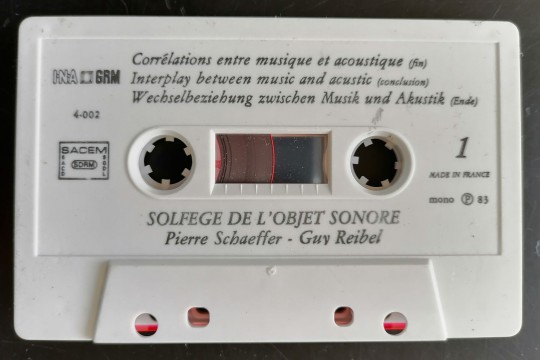

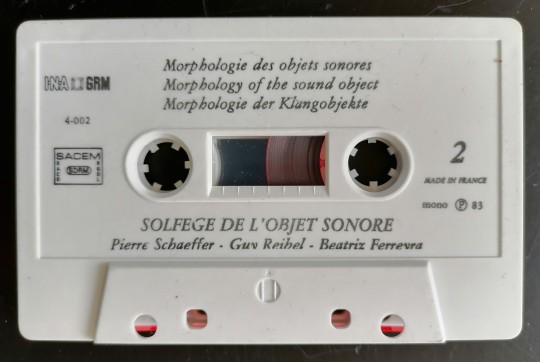


Pierre SCHAEFFER, Guy REIBEL & Beatriz FERREYRA
"Solfège de l'Objet sonore - vol.2: Attaques, Timbres, Morphologie"
(cassette. INA-GRM. 1983 / rec. 1967) [FR]
youtube
#pierre schaeffer#guy reibel#beatriz ferreyra#1967#france#electroacoustic#contemporary#spoken words#educational#musicology#cassette#grm#Youtube
5 notes
·
View notes
Text

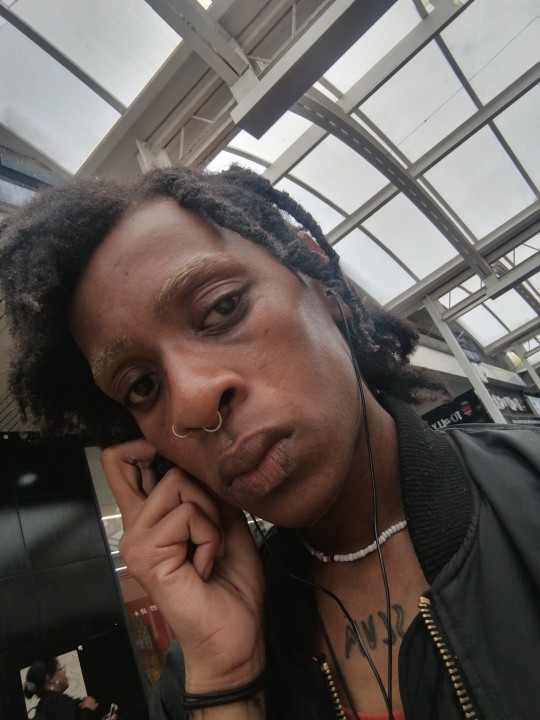



hair day part 3...
I did one side of the plaits, then had to go to a benefits appointment at 3pm with some weird asymmetrical frohawk type do (which was very fun to headbang with waiting for the bus), then I got back and learned the hard way that speed and digital hardcore is not the most conducive combo for detangling hair in a non destructive fashion... I did 2 sections the hxc way and the aggressive detangling resulted in that bowl of shed hair that you see up there, which I think is a tad more full than it ought to be (me and my tangles got in a couple fights)
switched to less aggressive music and did a few more plaits, like 70% done now but I need to sleep so the saga will continue tomorrow...
took a xanax ate some garlic rice and am now listening to a musique concrete show by beatriz ferreyra on nts about to read some simone weil
goodnight :)
7 notes
·
View notes
Text
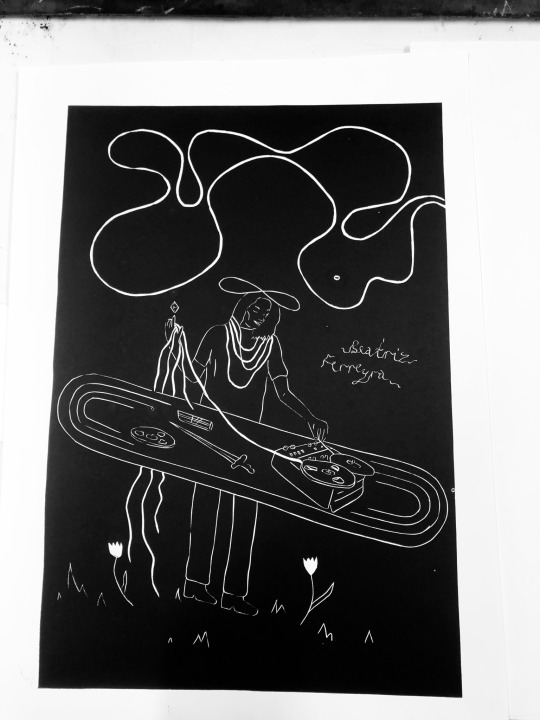

Linocut of Beatriz Ferreyra and Suzanne Ciani for the project Electric Magnetic Tarot.
3 notes
·
View notes
Text
Adrianne Munden-Dixon's album Lung, featuring my composition Seagrass/Reed, is a pick for the Best Contemporary Classical on Bandcamp, January 2023!
0 notes
Photo

Beatriz Ferreyra
at Kiezsalon | 27.06.2018
source: Beatriz Ferreyra FB
📸: ???
20 notes
·
View notes
Text
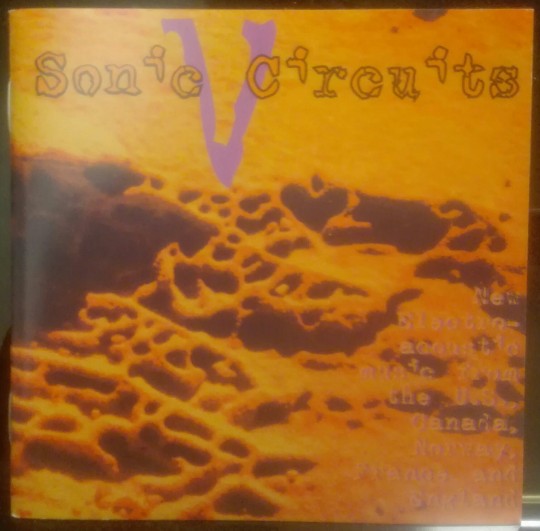


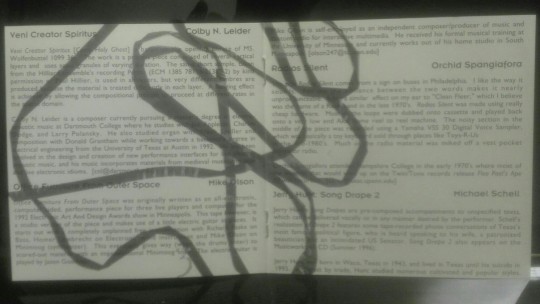
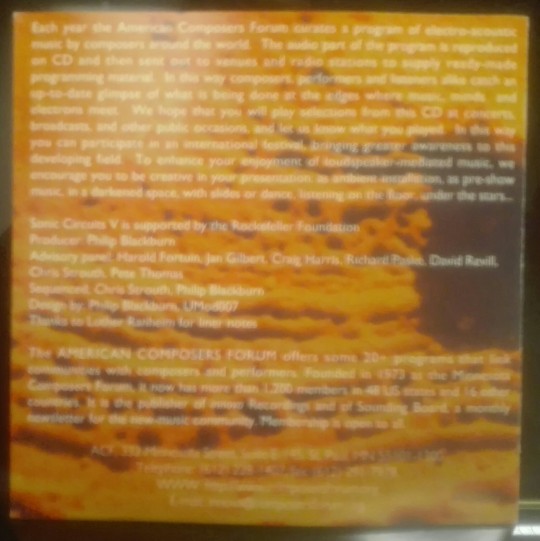
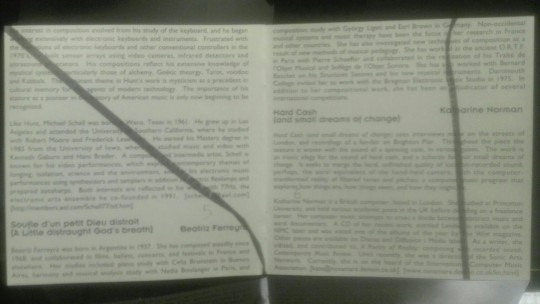

V/A
"Sonic Circuits - vol.5"
(CD. Innova Recordings. 1997)
youtube
#compilation#1997#contemporary#sound collage#abstract#lawrence pritts#robert normandeau#eirik lie#colby leider#mike olson#orchid spangiafora#michael schell#beatriz ferreyra#katharine norman#Youtube
2 notes
·
View notes
Text
RR17—3# Les programmes du jeudi 17 novembre au samedi 17 décembre
• Les créations sonores de RR * Beatriz Ferreyra « Echoes » (8′30)
• La voix du large de Lili Le Gouvello * La révolution des genres ¬ Rencontre avec Marie-Pierre (20′46)
• Les rencontres de RR * I C I l’atelier - céramique (32′03)
• L’interlude musical et pimenté de Thomas * Colombie & Brésil (10′)
• En attendant la plage —écritures contemporaines * Lucien Suel « Propager le Poème »
• Le billet cinéma de Benoît Muller * Journal cinéphile d’octobre (27′)
• Les rencontres de RR * L’éditeur Fabrice Caravaca et le poète Marc Guillerot (20′26)
• La ville sans salades ni ambages de Sébastien Madau * 4 étoiles (2′56)
• L’interlude musical et pimenté de Thomas * Afrique du Sud, France & Argentine (10′)
• Quartiers de culture —Conférence * Albert-Jean Morazzani « Le Che avant le Che » (65′24)
• Les découvertes musicales de RR au Club * La « rengaine-roule » Façon JuTu (36′57)
Les interludes : Los Miticos Del Ritmo « Fabiola » (Colombie) * Noriel Vilela « 16 Toneladas » (Brésil) * Mart'nalia « A Tonga da mironga do kabuleté » (Brésil) ¬ Muzi « People » (Afrique du Sud) * Jain « Makeba » (France) * La yegros « Iluminada » (Argentine)
#poésie contemporaine#musique du monde#transisbeautiful#céramique#design#politique de la ville#Musique expérimentale#histoire#le che
0 notes
Text
youtube
Week 7 Notes on Lecture
Sonic Materialisms
Explore sounds musical potential
Experimental capture and composition of sonic material
Music concrete
Assembled into a form of montage a musical composition that utilises sounds as raw material. The sounds are often modified the sonic materials are already pre-existing repurposed. Shaeffer, Pierre pioneering researcher GRM.
Take a sound from whatever source and we listen through a process of comparison within our perception. Shaeffer’s Seminal (1948) claims it is the first piece of music concrete, manipulating sounds of trains.
Lots of character, I liked the simplicity, my visual perception narrative was it was just a day in the life and communication of trains. The sound of trains relating to one another just doing a day’s work chatting away with each other to get the job done.
Acousmatic sound listening is without an originating cause being seen.
Music and sound are specifically composed for presentation using speakers.
GRM. Invisible sound source, sound is detached from source, visualise, or perceive it
It was highlighted during this period the sound replaced the score, and that this type of music was an art form that isn’t traditional as it subverted music conventions.
The inversion of the compositional process was not bound to the traditional instrument and the score. This type of subversion can be dated back further to Halium Dabh’s piece (1944). Wire recorder piece. It’s like a recording of a collective spiritual prayer or chant.
The original recording was an exorcism ceremony. Context verses extraction
Halim El-Dabh, was an Egyptian artist who produced this music piece using samples taken from an ancient Egyptian "Zar" ceremony. He first presented his piece at an art gallery event in 1944.
Cited on youtube: “According to El-Dabh:
"I just started playing around with the equipment at the station, including reverberation, echo chambers, voltage controls, and a re-recording room that had movable walls to create different kinds and amounts of reverb." He further explains: "I concentrated on those high tones that reverberated and had different beats and clashes, and started eliminating the fundamental tones, isolating the high overtones so that in the finished recording, the voices are not really recognizable any more, only the high overtones, with their beats and clashes, may be heard." This was recorded onto magnetic tape and called The Expression of Zaar, which was publicly presented in 1944 at an art gallery event in Cairo.”
youtube
In class we then discuss the
The role of the telling – embodied experience of listening – listening practice.
In acousmatic listening where do we position ourselves and meaning making.
We had a live discussion about the influences of identity and geography with some students seemingly unaware of the importance of diversity in our current cultural context and geographical location and other students vividly aware of these very real existing tensions and differences. Differences in subjectivity and experience that position one’s standpoint to affect one’s sound making, listening and perceiving. We then moved onto
Beatriz Ferreyra
youtube
Beatriz Ferreyra is one of only a few female concrète composers. Her work is important as it is both complex and elegantly simple.
We listened to a piece of sound and discussed afterwards what our creative process was like. For me I immediately reacted to this piece by writing. It triggered a lot of visual imagery and a story.
How do you bring your listening to this process. Today’s lecture brought a new layer to listening to sound.
Felt like a building of Tension and chatter and my visual perception set this narration between cows and aliens. In a little argument with each other until the big alien ship came and called the aliens away. Some of the aliens went a bit mental because they were wound up. Then they were quietened by their caregivers and returning to their home. Put into their rooms and told to be quiet. The deeper noises were the caregivers telling them to stop acting out.
The sounds of the ether the unfamiliar – almost like whining kittens
Moved to the sound of the parents and elders moving along with all the brats underneath them whining.
Then to a much more peaceful sound more serene setting perhaps the morning prior to the waynes waking up and causing a riot. Sounds of ether and the transmission of the adult aliens organising their day between their homes. Then there is a rise in tension again a kind of haunting sound of birds that isn’t quite a human known setting. The sound of transmission poles across a distance.
Then some whining waynes wake up and begin playing and having a laugh quite joyful and free and busy. Contrasted to some classrooms and rote learning of rhymes and rhymical class contribution of the alien times table.
Then cuts to maybe the sound of an alien work environment and the rhythms of the machinery and presses whatever they maybe. Then the sound of lunch and these sounds quieten and slow down. The sound of a bell and an alien cookoo and then it stops.
This piece cut splice and reappropriating the content. It had a lot of depth and distance mini progression, changing of pitch, eavesdropping, moskito not aliens?
Acousmatic – temporal medium it’s not static – think about duration whether it is important do I want to close this down and position people the openness of the 12 min work.
Piece was liked because it involved taking the listener somewhere. I enjoyed the piece.
How do I come to sound well like all of my art and creative expression I use as some sort of art therapy its my creativity helps me function as a way of processing my emotions.
I also use it as a tool for self-development and political messaging especially in relation to minorities.
Perceive feel and heal. Forced to think differently any abstract stream relax into an unprejudiced receptivity. Strategy and meaning to sound.
After such vibrant and engaging sound art we then heard a contrasting piece from Hildegard called cricket voice. Which I simply could not get past my initial judgement of this artists work. Which is interesting as it evidences for me the importance of standpoint and the power this has on one's perception. it influences one's motivation in such a cunning way that it can block one's desire to engage, which isnt a all bad.
youtube
I reacted in a judgemental closed negative way to this work and some of the other work of this artist and their explanations about their process, because I can't relate to there white, middle class heterosexual positionally. I begin to judge this artist for their middle classness and overly romanticised privileged view of life, sound art and its difficult for me to get past my judgement that their work is then self-indulgent noise. It can only be perceived and enjoyed from a limited privileged plain and to me totally judgementally what’s the point. What’s the point to provided sound it leaves me feeling disappointed that it is not more self-reflective, or subversive or political. This is why I described it as self indulgent as it only caters to a particular class perception.
Found it difficult to engage with, some interesting sounds of what seemingly mimics mobile new technology and mobile phone noises. I switched off due to the title of already knowing what sounds originated from. Found it difficult to ascribe meaning. What was its purpose it felt self-indulgent. I liked the murmur of what sounded like a Buddhist chant for 2 seconds, the rest was white noise that left me feeling irritated. It has been described as the heartbeat of the desert which – yes it may well be from your stance of white, heterosexual and middle classness.
Thankfully the next piece saved the day. Its the most inspiring piece I have heard thus far in my studies -
Steve Reich. Come out 1966 composer asked to edit down tape footage for the suspects named Harlem 6 who were wrongly arrested for murder 1964. The voice in the piece was of
The audio used for "Come Out" was selected by Steve Reich from over 70 hours of audio given to him related to The Little Fruit Stand Riot in 1964. The young man speaking on the tape is Daniel Hamm, age 18, a local Black resident and he was part of a group of young men known as the "Harlem Six." Mr. Hamm was not involved in the fruit stand incident, and was only trying to protect children from the police. He was still beaten severely by police and spent over 8 years in prison. …we heard children scream. We turned around and walked back to see what happened. I saw this policeman with his gun out and with his billy in his hand I like put myself in the way to keep him from shooting the kids. Because first of all he was shaking like a leaf and jumping all over the place. And I thought he might shoot one of them.
Hamm and another Black resident Wallace Baker were taken to a police station for their efforts to stop the violence, where groups of police took shifts to beat them for several hours. It is Hamm’s voice around which Come Out is composed.
“Severely bruised, the police refused to take him to hospital because he was not bleeding. Hamm speaks to tape: ‘I had to, like, open the bruise up, and let some of the bruise blood come out to show them.’ Hamm and Wallace were eventually released, pending charges over the fruit stand riot, despite the vendor testifying they had nothing to do with it. “ https://meshworkradio.home.blog/tag/daniel-hamm/
Steve Reich (1966) composed this piece to help with the campaign.
youtube
Steve Reich was first sound composer to explore the concept of phase modulation and minimalism in his work.
4 sec loop on tape. Process time duration important think about repeat technique, reproduced. Come out to show them is on repeat.
Forces the listener to think about the racist abuse, the power dynamic, the lack of trust and respect that black people have been given. I began thinking about the words come out black people are asked to perform to the white police and within a dominant white frame, I thought about the power dynamic involved. They are consistently asked to demonstrate approval of their experience their very existence. Over and over they are asked to fit into a White experience of the world, which is considerably demising, harassing and completely unreasonable. The repeat and rhythms brings in time the thought that this is never ending power imbalance, its happened within history and it is still ongoing and never ending racism and abuse of power. This piece is brilliant excellently composed and very impactful.
The repeat and the length of the piece is powerful and signals the pervasiveness of the racism, lack of trust, lack of respect given to black people within the legal system I don’t think he could have given a better way to deliver this message.
0 notes
Text
Supersonique 2022 programme
La programmation de Supersonique 2022 est établie. Les horaires sont donnés à titre indicatif.
Supersonique 2022 program is now finalised!
Follow the stream on https://p-node.org (binaural stream)
> 12h
interprète : Inés Be
Mattia Parisse / Brulicautoma
François Parra / Organocomique#2
Flore Silly / Flash 3
Camille Lacroix / Transformateur destiné à utiliser les petites énergies gaspillées
Yun-Ju Ma / Vol des étoiles
> 13h
interprètes : Raphaële Dupire, Thomas Atienzar
Jacques Boyer / A la dérive
Ema Ferreira / Three Buchla Studies
Laura Badie / Étude au brouillard
Juliette Chartier / Cimetière spatial
Sophie-Charlotte Gautier / Petite nature
Michèle Bokanowski / Tabou
> 14h
interprètes : Giz Medium, Loreto Martinez Troncosco
Fernando Curiel / Escenasonica
Mélodie Duchesne / Tergiversations
Bérangère Maximin / Off the Page
Eliane Radigue / Biogenesis
> 15h
interprète : Isotta Trastevere
Nicolas Jacquot / Diego
Felipe Leon Ortega / Las palabras
Andres Quezada / Asimetria
Beatriz Ferreyra / La ba-balle du chien-chien à la mé-mère
Loïc Guerineau / Prélude à l'Apocalypse de Pierre
L'oreille interne / Joséphine
Pom Bouvier-b / La fleur du bourdon : Fraction
Marco Marini / Pardon
> 16h
Temps de découverte de la musique électroacoustique (par Pascal Gobin, Alain Aguilar, Franck Barriac)
> 17h
interprète : Philippe Petit
Elżbieta Sikora / Rhapsody for the Death of a Republic
Florine Mougel / A Brûle pourpoint
Langham Research Centre / Terminal Voltage Traces
Gabriel Prokofiev / Strange Blooms-IV - Cadence
Laure Lang / EnvironMental
> 18h
interprète : Lundja Medjoub
Seth Rozanoff / Surfaces
Halim El-Dabh / Wire Recorder Piece + Leiyla and the Poet
Sarah Procissi / Terra Santa
Léa Thirion / The Rain Falling Through Our Minds With Glittering Pieces
Leonardo Fabini / Pan en pasi
> 19h
interprète : Iris Kaufmann
Aude Rabillon / Pour ne plus taire les jours où
Nick Klein / Pfefferspray
Sarah Ouazzani / Presque loup
Johann Philippe / Chien ailé
> 20h
interprètes : Flore Silly, Loreto Martinez Troncoso
Toru Takemitsu / Sky, Horse And Death
Rheda M / موجة هيرتزعلى الطريق الحارقة
Erik Avert / Louppe - A Gilded Eternity
Delia Derbyshire / Falling, from The Dreams
> 21h
interprète : Samuel Bester
Camille Gallice / Elsa Au miroir
Duncan Pinhas / Météores
Paolo Montella / Ossa
Naujawanan Baidar / Simetry of Knives
Valérie Vivancos / Summstein
Giz Medium / Rovina-Rudero
Eric Dode / Romanigro
> 22h
interprètes : Louise Balalas, Loïc Guerineau
Hortense Gauthier / Poème-descente
Francisco Meirino / Father a Still Life
Mélanie Gentilhomme / Les coquelicots
Jacques Brodier / Extrait du 'filtre de réalité'
Aurélie Nyirabikali Lienman / Iota mikro
Tyfen Guilloux / Tacet tacan
Ond / The Tired Sound Of Coud iN the Brain
> 23h
interprètes : François Parra, Mélodie Duchesne
Inès Bernard-Espina / Humus électrifié
Monÿang / Vàha
Nicola Cappelletti / Parataxe parallaxe
Marco Dibeltulu / Il nastro di Möbius
Hasan Hujairi / Hijaz
Hildegard Westerkamp / Talking Rain
1 note
·
View note
Text
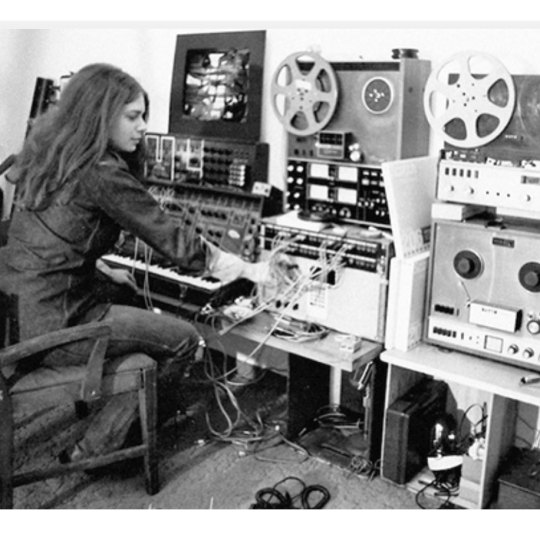
Beatriz Ferreyra
220 notes
·
View notes

